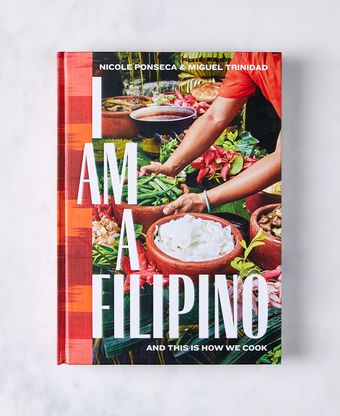What a cool ride this was for my husband and me. As two foodies (I define “foodies” as people who don't go out to eat, but rather prefer to stay home and eat meals that we create ourselves), it was so much fun to try a few recipes from I Am a Filipino by Nicole Ponseca and Miguel Trinidad, and Mastering Pizza by Marc Vetri. We eventually had to pick which book was our favorite, and our top choice really surprised us!
First, a little background. I'm half Albanian, a quarter Italian, and a quarter Irish. My husband is half Sicilian and half Chilean. Between the two of us, we have some pretty solid food genes. Because of my Albanian side, I grew up on a Mediterranean-oriented diet of lamb, potatoes, eggs, olives, and salty sheep’s milk cheeses, like feta. And my Italian heritage (from Naples) brought me beautiful cheeses and cured meats (my favorite), bread, pizza, olives, more cheese, and good wine.
My husband’s family has slightly different staples, which I learned when I met them for the first time, and got to know even better when we got married six months ago. His Sicilian side favors fish, as well as risotto and pasta dishes, many of which are flavored with bright citrus and include lots of fresh vegetables (like my favorite, cucuzza, Sicilian summer squash). And as for his Chilean side...well, they eat the most glorious beef ever! My new Chilean family has opened up my eyes and palate to a world of awesome tropical fruits and citrus, avocados, unique soups and meat stews, empanadas, BBQ, and beautiful fish, many of which are flavored with various regional chiles and spices.
While we have a wide variety of ingredients and dishes we like to play with, we both tend to stick pretty close to the recipes and tricks that were handed down to us by our families. So we were incredibly excited to try out two new books to learn more about cuisines and techniques we're not already familiar with.

I Am a Filipino gave us an amazing chance to educate ourselves on Filipino culture and cuisine. Nicole Ponseca and Miguel Trinidad made this adventure fun and simple, with the vivid photography captured in the Philippines itself, and detailed but easy-to-follow recipe instructions. I also loved how the authors taught us about the background of each dish, explaining why and how people in the Philippines enjoy each savory meal, dessert, or drink included in the book. The knowledge and research they brought to every recipe was fascinating.
I was intrigued by a lot of the recipes, but a few in particular stood out because they used ingredients I know something about, but in such different ways than I’d experienced or could ever even imagine. So I picked three recipes that would really challenge us, even as people who love to cook at home. With a whole chapter on Adobo, a sauce common in Filipino cuisine but also an important cooking method, I began there. I started with the Adobong Puti, or duck in a white adobo sauce (it’s seasoned with salt instead of soy sauce, along with a bunch of spices and the traditional vinegar).
Full disclosure: I've never eaten much duck, except for the occasional instinct to try something different when out with friends. And even though I enjoy eating it, I'll admit I was totally scared to cook it. What if I messed it up and it was rubbery-overcooked, or totally raw? But the recipe was easy, I managed to cook the duck without messing it up, and the adobo sauce was so yummy. Since I made that dish, I've been trying to figure out how to incorporate warm, sweet spices (like cinnamon, star anise, tamarind, turmeric, and ginger, to name a few) into our favorite savory dishes.
Next, I made the Puqui-Puqui, a charred eggplant dip with eggs and tomatoes. This recipe was overall pretty simple. First, I broiled some Asian eggplants, removed their skins, and pureed them. (Peeling the eggplants was not that easy, but thankfully my husband was there to help.) Then, I mixed the peeled eggplant puree with sautéed onions and tomatoes, whisked in a raw egg, and cooked the mixture until it got thick and creamy. The recipe suggests topping the cooked dip with a fermented seafood paste called bagoong isda, and it’s totally optional. Though I wasn’t exactly sure where to get this paste from, we live in a neighborhood of Queens with some fantastic Asian markets, and the lovely folks at one helped me find it.
Last, we made dessert together, and while doing so also found some similarities between Filipino cuisine and the Chilean recipes my husband is familiar with. We made the Leche Flan, with creamy and sweet coconut milk and condensed milk. It came together easily and we could barely wait for it to chill before digging in.

Next, we cooked from Mastering Pizza by Marc Vetri, which was a little closer to home. With Sicilian and Italian backgrounds, and people who have both eaten our fair share of pizza over the years, my husband I were like, "Sweet! We get to make pizza!" We love pizza. Like, a lot. But truth be told, we don't usually cook it ourselves (we leave the dough-making to my Auntie, who is brilliant at it), so we were looking forward to the challenge.
Cooking pizzas from scratch together was a fun experience, and Marc Vetri is an amazing teacher. Even though the instructions for pizza dough were detailed and really thorough (there's a whole chapter on it, with about a dozen different dough recipes), I won't lie—making dough from scratch is tough, y'all. We spread out the pizza-making over the course of three weeks, due to travel, work, and holidays. So we made 3 separate batches of dough.
Particularly, we found the beginning steps to be tricky. Putting together dough is a science and you have to be pretty exact with measurements, otherwise it won't rise correctly and won’t taste right. I noticed if there was a touch too much oil, or not enough salt, it didn't knead well...which brings me to that part...kneading. It's a workout! So if you're into that, you're gonna love the arm exercise you'll get from making dough. (If you’re not into that, I recommend using a KitchenAid stand mixer. They are the best.) After measuring and kneading, the dough had to rest and ferment for between 24 hours and 3 days, depending on the dough recipe. This extra time gives the dough extra flavor, and is another reason why I had to split up the pizza recipes into a few batches.
But here was my least favorite part: THE MESS. We have a big kitchen, which is a blessing in N.Y.C. But our dough kept coming out sticky both before and after the fermenting stage, so we had to continually add flour to our countertops and dough so we could work with it. And then our kitchen would become a floury mess. Six times! If you have an industrial-size kitchen with metal counters, and a very good mop (or, if you're an expert dough maker who knows how to do it without making a mess), you will love this book.
Mess aside, we were excited to try out two different savory pizzas and one sweet, to get a good variety from the book. We picked recipes with ingredients and flavors that we love: The Patata Pesto (potato and basil pesto pizza), the Prosciutto and Arugula Al Taglio (prosciutto and arugula pizza), and the Fresh Berry Mascarpone Pizza. Once we got the doughs together, the pizzas were pretty easy to make—and the flavor combinations were incredible.
First, we started with the Patata Pesto pizza, which uses a Roman-style dough with olive oil in it. This dough is thinner and crispier than the chewy kind we love from Naples. But it can be rolled out really thin with a rolling pin instead of hand-stretched, which definitely made things easier. And the fingerling potatoes on the crunchy pizza dough were so good. We thought the baking part of this process would be as tough as the dough-making, but it was actually pretty easy. Though Marc suggests using a pizza stone (I wish we had one), turns out that any pizza pan will get the job done well enough. We have two regular round pizza pans—one with tiny holes on the bottom, and one without—and we preferred the one with the holes so the dough could breathe and get even crispier without burning.
The second pizza we made was the Prosciutto and Arugula Al Taglio, which I particularly loved (told you cured meat was my fave!). This square-shaped pizza made in a baking sheet uses a different kind of dough, "Al Taglio" dough, which is thicker and more like bread than the dough we made for the potato pizza. Marc instructs you to warm the prosciutto and arugula in the oven for a minute after baking the dough. This crisped up the cured meat and slightly wilted the greens. Salty, peppery deliciousness.
We loved the savory pizzas, but my favorite by far was the Fresh Berry Mascarpone Pizza, in the book’s final chapter on dessert pizzas (a whole chapter!)—we've never eaten anything like that before and it was absolutely delicious. This pizza also uses the Roman dough, rolled out thin. The fruit, paired together with creamy mascarpone, was out of this world. In fact, it actually inspired us to make little dessert cups of just mascarpone cheese, berries, and honey as little after-dinner treats, even once we’d used up the pizza dough.

We liked cooking from Mastering Pizza, but felt it lacked the variety of techniques and tastes we wanted to see, though we could definitely feel Marc Vetri’s level of passion for the craft. Marc and his team do a good job breaking down the process, but they made it look and sound so much easier than it is—after all, they are expert pizza makers, and sadly, I'm not. There were some definite pluses to Mastering Pizza, though, including the availability of ingredients (all of which we were able to pick up from our local grocery store). If you're not near an Asian or an international market, you may have a tough time getting some of necessary spices, pastes, and produce that I Am a Filipino requires.
But for us, the shopping adventure was worth it. I Am a Filipino had an array of varying dishes, flavors, ideas, and, most importantly, heart. Nicole Ponseca and Miguel Trinidad’s love of sharing food with people was so clear, and ultimately, was why we chose this book as the winner.



10 Comments